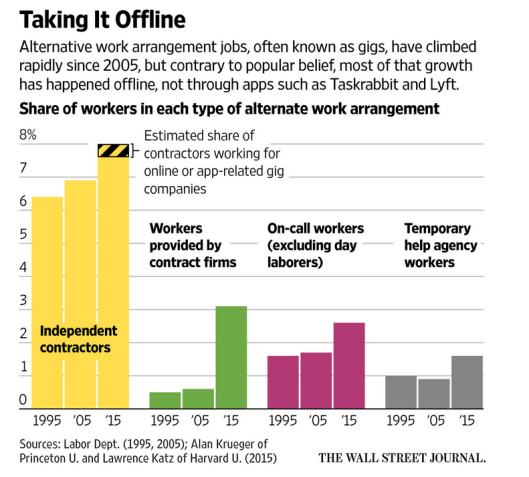I just looked up the term “gig”.
Merriam-Webster provides 4 definitions: “Something whirled, someone of grotesque appearance, a rowboat, and a two-wheeled one-horse carriage”.
Clearly that’s not what we are talking about.
Even the Urban Dictionary is behind the times with its description “A live performance, either musical, theatrical, or physical.”
Curiously, the Urban Dictionary managed to misspell the word tomorrow in its example “The band has a gig tommorow night.”
The Wall Street Journal uses the term “gig” meaning an “alternative work arrangement job”.
With that definition in mind, how big is the “gig” economy?
New research shows labor shift affects health care, education and other industries that have traditionally offered stable employment. However, the Wall Street Journal reports Contract Workforce Outpaces Growth in Silicon-Valley Style ‘Gig’ Jobs.
“Uber drivers aren’t the only “gig” workers rattling the U.S. economy. Older workers, especially women, increasingly are filling in as contractors across a range of traditional industries, from highway inspectors to health aides.
As companies look to shed noncore tasks and government budgets come under strain, an expanding share of the workforce has come untethered from stable employment and its attendant benefits and job protections.
The explosive growth of Silicon Valley companies such as Uber Technologies Inc., where on-demand drivers summoned by an app set their own hours and are paid by the ride instead of an hourly wage, has shined a bright light on the so-called gig economy. But new research shows this shift away from steady employment has taken place largely in the shadows.

The Labor Department breaks down the four main types of alternative work arrangements into independent contractors, on-call workers, temp workers and workers employed by contract firms, but it hasn’t updated its count of such workers since 2005.
Messrs. Krueger and Katz hired Rand Corp. to replicate the survey, sampling roughly 4,000 people. The findings show how alternative work has spread across industries and occupations—including those not associated with the gig economy.
For example, they estimate the share of workers in alternative arrangements has more than doubled to 11% in manufacturing and to 16% in health and education. It has quintupled, to 10%, in public administration.
Workers in these alternative arrangements often find themselves with erratic schedules, spotty earnings and few benefits such as health insurance, Social Security or a retirement plan.”









Leave A Comment